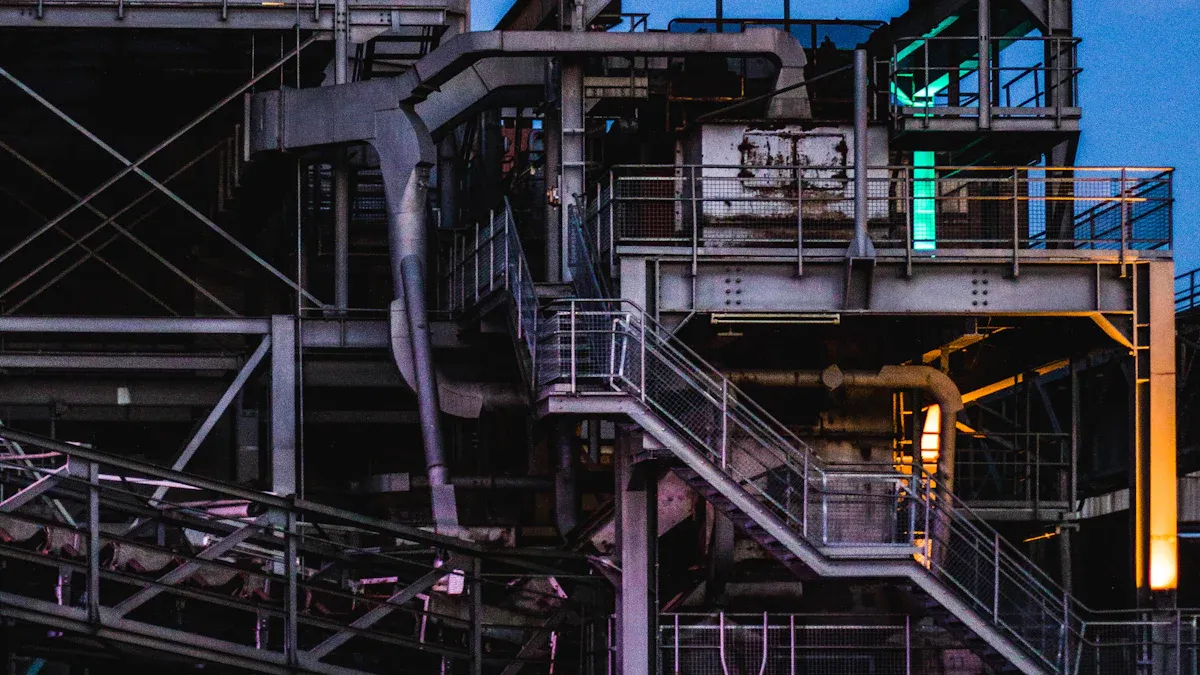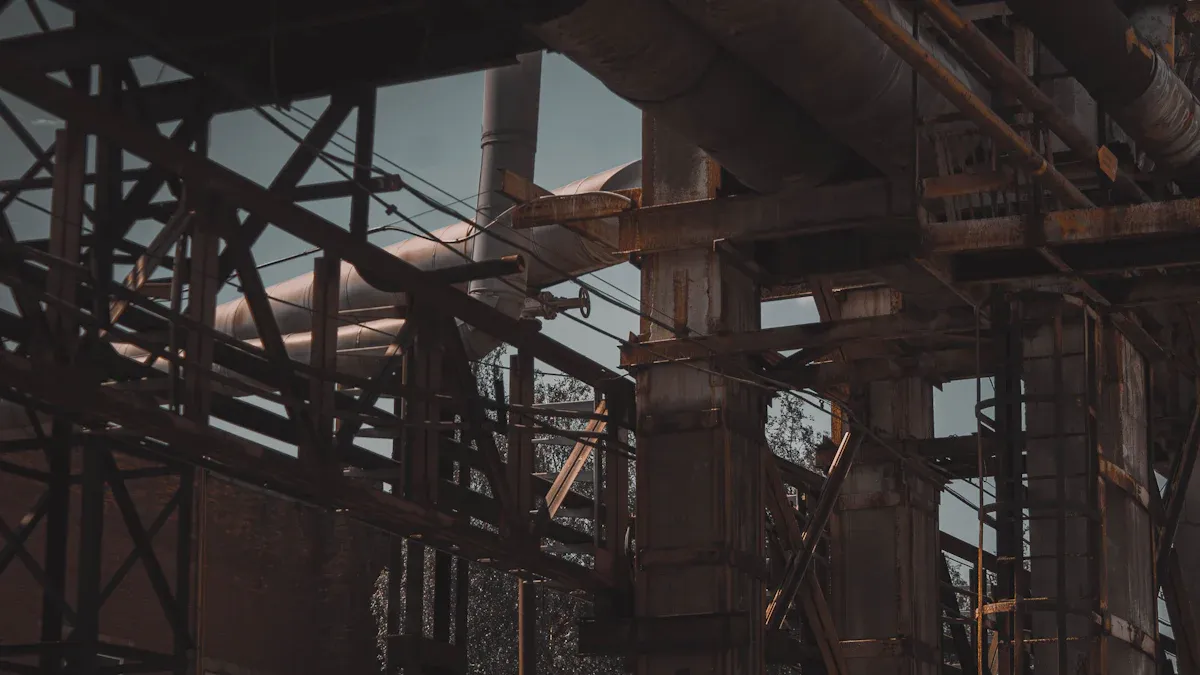Compare Vacuum Heat Treatment and Thermomechanical Treatment

Key Differences Between Two Treatments
Explore the distinctions between vacuum heat treatment and thermomechanical treatment.
Features | Vacuum Heat Treatment | Thermomechanical Treatment |
|---|---|---|
Oxidation Prevention | Prevents oxidation using a vacuum. | May cause oxidation without coatings. |
Mechanical Properties | Enhances strength through heat and cooling. | Improves toughness via heat and pressure. |
Dimensional Stability | Maintains accurate shapes during processing. | Can cause minor shape changes. |
Energy Efficiency | More energy-efficient with sealed furnace. | Requires more energy due to shaping. |
Process Complexity | Simpler and more predictable process. | More complex, requires careful balancing. |
Applications | Ideal for precise, rust-free parts. | Best for tough, load-bearing materials. |
Cooling Method | Uses slow cooling in a vacuum. | Cooling rate varies with shaping. |
Material Suitability | Works well with steel and titanium. | Effective for steel, aluminum, and titanium. |
Choosing the right process can greatly affect material performance. Vacuum heat treatment heats metals in a vacuum to stop rust and make surfaces better. Thermomechanical treatment uses heat and pressure to make materials stronger and tougher. Knowing these methods helps you pick the best one for your material and its use.
Vacuum Heat Treatment
Definition and Process
Vacuum heat treatment improves metals by heating them in a vacuum. This stops oxygen and gases from causing rust or damage. The metal is placed in a vacuum furnace, which removes air. The furnace pressure drops to about 0.1Pa. The metal is heated to a set temperature, like 520-560℃ for nitriding. After heating, nitrogen gas is added, raising the pressure to 50-70Pa. The process ends with slow cooling to keep it even and accurate.
This method is popular because it creates clean, high-quality results. For example, in 2023, the vacuum heat treatment market was worth USD 860 million. By 2032, it is expected to grow to USD 1.45 billion, showing its growing importance in industries needing strong materials.
Key Features and Benefits
Vacuum heat treatment has many benefits for different uses. The vacuum stops surfaces from rusting, which is important for precise parts. It also makes metals stronger, harder, and more resistant to wear.
Vacuum furnaces heat and cool metals evenly, improving their quality. Industries like aerospace and automotive use this method for exact material properties. It also saves energy by reducing heat loss and using resources efficiently.
Common Applications and Materials
Vacuum heat treatment is used where strong materials are needed. In aerospace, it’s used for turbine blades and landing gear. In cars, it’s used for gears, shafts, and bearings. It’s also important for power plants and medical tools.
Common materials treated include steel, titanium alloys, and other strong metals. Aerospace especially benefits from the stronger and longer-lasting materials this process provides. In 2023, the vacuum heat treatment furnace market was worth USD 810 million, and it’s expected to grow due to its many uses.
Thermomechanical Treatment

Definition and Process
Thermomechanical treatment uses heat and force to make materials better. First, the material is heated to a set temperature. Then, it is shaped or pressed while still hot. This changes its structure, making it stronger and tougher.
The process carefully controls things like heat, cooling, and pressure. For example, the cylinder cools five times slower than the workpiece. This keeps stress and shape changes even. Below is a table showing key details:
Parameter | Value | Description |
|---|---|---|
Density | 7900 kg/m³ | Weight of the material (X10CrNi18-8 steel) |
Thermal Conductivity | 14.5 W/m·°C | How well heat moves through the material |
Specific Heat Capacity | 0.5 kJ/kg·°C | Heat needed to raise the material's temperature |
Coefficient of Heat Transfer | 6 W/m²·°C | How heat moves from air to the material |
Cooling Rate Ratio | 5:1 | Cylinder cools five times slower than workpiece |
Axial Stress Formula | σᵣ = αₜ · ΔT · E · (Sₜₕₐf / Sₒₜₒ) | Formula for stress during heating |
Total Strain Formula | εₛ = εᵧ + εₚₗ + εₜ | Total strain from elastic, plastic, and heat changes |
This method ensures the material gets the exact properties needed. It’s great for tough and precise uses.
Key Features and Benefits
Thermomechanical treatment has many advantages. It makes materials stronger, tougher, and harder to wear out. By using heat and force together, it creates unique properties.
Unlike vacuum heat treatment, this method changes the inside of the material. It also controls grain size, which affects strength and toughness. This makes it perfect for jobs needing strong and durable materials.
Common Applications and Materials
Thermomechanical treatment is used in construction, cars, and airplanes. It’s great for parts that handle heavy loads, like beams, gears, and shafts. Materials like steel, aluminum, and titanium work well with this process.
For example, in cars, it makes engine parts last longer. In buildings, it strengthens steel beams for tall structures. This process is useful in many industries because of its flexibility.
Comparing Vacuum Heat Treatment and Thermomechanical Treatment
Oxidation Prevention and Surface Quality
Vacuum heat treatment stops oxidation by using a vacuum. This removes oxygen and gases that cause rust or stains. The metal stays clean and smooth, with no discoloration. It’s perfect for parts needing a shiny and precise finish.
Thermomechanical treatment doesn’t naturally stop oxidation. It uses heat and shaping in open air or controlled spaces. This can cause the surface to rust. But adding coatings or protective layers can help reduce this problem.
For a flawless surface, vacuum heat treatment works best. It gives a clean finish without extra steps.
Mechanical Properties (Strength, Hardness, Durability)
Both methods make materials stronger, but in different ways. Vacuum heat treatment changes the inside of the material with heat and cooling. This boosts strength and hardness, making it resist wear and last longer. For example, higher quenching temperatures increase hardness, while tempering changes final hardness.
Thermomechanical treatment uses heat and force to make materials tougher. It changes the grain structure, helping materials handle heavy loads. For instance:
Materials stretch over 9% before breaking after this process.
Impact toughness and strength improve with controlled shaping.
If you need tough materials for heavy stress, thermomechanical treatment is better.
Deformation and Dimensional Stability
Vacuum heat treatment keeps shapes stable. Heating and cooling evenly in a vacuum lowers stress. This stops warping and keeps parts accurate, like in aerospace tools.
Thermomechanical treatment can cause small shape changes from applied forces. But controlling cooling and pressure can reduce these issues.
For exact shapes and sizes, vacuum heat treatment is more dependable.
Energy Efficiency and Process Complexity
When choosing between vacuum heat treatment and thermomechanical treatment, energy use and process difficulty are important factors.
Energy Efficiency
Vacuum heat treatment saves energy by using a sealed furnace. This setup keeps heat from escaping and uses energy wisely. Cooling also needs less power because the vacuum reduces extra cooling needs.
Thermomechanical treatment uses heat and force together, which takes more energy. Shaping materials with large forces adds to energy use. Open-air or controlled spaces can lose more heat than a vacuum. But newer machines have made this process more energy-efficient over time.
If saving energy matters most, vacuum heat treatment is the better option.
Process Complexity
Vacuum heat treatment is simple but precise. The vacuum furnace removes air, making results consistent. It’s easier to control, but the equipment needs special skills to run and fix. This might take time to learn.
Thermomechanical treatment is more complicated. You must balance heat, cooling, and force carefully. Timing is key, especially when shaping hot materials. This method allows more customization but needs skilled workers and advanced tools.
For an easier and more predictable process, vacuum heat treatment works best. If you need custom material properties and can handle the complexity, thermomechanical treatment is a good choice.
Applications and Suitability
When to Use Vacuum Heat Treatment
Vacuum heat treatment is great for clean and precise results. It’s best for jobs where rust or dirt would ruin the material. For example, turbine blades and medical tools need smooth, rust-free surfaces.
This method is also good for materials needing specific hardness. Steel parts with 400-440 HV1 hardness resist wear during machining. Vacuum-treated maraging steel joints can reach over 300 MPa shear strength. Their hardness is about 426 HV1 after tempering. These features make it popular in aerospace, automotive, and power industries.
If your project needs stable shapes and sizes, this method is ideal. The vacuum furnace heats and cools evenly, reducing stress. This keeps parts like gears and shafts accurate and within tight size limits.
When to Use Thermomechanical Treatment
Thermomechanical treatment is best for tough and strong materials. It’s perfect for parts under heavy loads or stress. Construction beams, car gears, and airplane landing gear benefit from this process. It improves grain structure and makes materials more durable.
Choose this method if you need specific internal material properties. Heat and force together create materials that stretch over 9% before breaking. It also boosts impact toughness, making it great for parts facing shocks or vibrations.
This process works with many materials like steel, aluminum, and titanium. If your project needs custom properties and can handle a complex process, thermomechanical treatment is a great choice.
Factors to Consider for Selection
When picking between these methods, think about these factors:
Material Needs: For clean surfaces and no rust, pick vacuum heat treatment. For stronger insides and better grain, choose thermomechanical treatment.
Application Use: Think about the stress and environment the material faces. Vacuum heat treatment is best for precise parts. Thermomechanical treatment works for heavy-duty jobs.
Process Simplicity: Vacuum heat treatment is easier and more predictable. Thermomechanical treatment is harder but allows more custom options.
Energy Use: Vacuum heat treatment saves energy with its sealed furnace.
By considering these points, you can pick the best method for your project.
FAQ
What is the main difference between vacuum heat treatment and thermomechanical treatment?
Vacuum heat treatment stops rust and keeps surfaces smooth. Thermomechanical treatment makes materials stronger using heat and pressure. Pick based on whether you need clean surfaces or tough materials.
Which method is better for precise dimensions?
Vacuum heat treatment is best for keeping exact shapes. Heating and cooling in a vacuum lowers stress and stops warping. This makes it great for parts needing tight size limits.
Can both methods be used for aerospace applications?
Yes, both methods work for aerospace needs. Vacuum heat treatment is good for smooth, rust-free parts like turbine blades. Thermomechanical treatment strengthens parts like landing gear for heavy use.
How do energy requirements compare between the two methods?
Vacuum heat treatment uses less energy because of its sealed furnace. Thermomechanical treatment needs more energy since it uses heat and force together.
Which process is easier to control?
Vacuum heat treatment is simpler to manage. It heats metals in a vacuum furnace. Thermomechanical treatment is harder because it balances heat, pressure, and cooling.
See Also
Exploring Various Heat Treatment Techniques and Their Applications
The Role of Thermal Management in Extending EV Battery Longevity
Surface Treatment Methods for Effective Metal Cleaning and Degreasing
Boosting Engineering Efficiency with Quick Response Strategies
Understanding Functional Testing in CNC and Die Casting Operations
About Hunan Puka
Established in 2016 and based in Hunan, China, with a liaison point in Berlin, we are a Tier 2 supplier for the automobile industry. We specialize in the production of customized aluminum die-casting parts designed for machines with a closing force ranging from 280 to 1250 tons, with subsequent manufacturing process CNC machining and surface treatment. Our commitment to quality is reflected in our accredited quality management system, certified by ISO9001:2015 and IATF16949:2016 standards.


